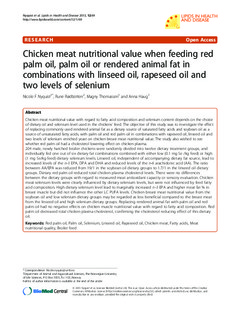| dc.contributor.author | Nyquist, Nicole Frost | |
| dc.contributor.author | Rødbotten, Rune | |
| dc.contributor.author | Thomassen, Magny S. | |
| dc.contributor.author | Haug, Anna | |
| dc.date.accessioned | 2017-09-26T10:07:43Z | |
| dc.date.available | 2017-09-26T10:07:43Z | |
| dc.date.created | 2013-06-07T14:08:57Z | |
| dc.date.issued | 2013 | |
| dc.identifier.citation | Lipids in Health and Disease. 2013, 12 . | |
| dc.identifier.issn | 1476-511X | |
| dc.identifier.uri | http://hdl.handle.net/11250/2456723 | |
| dc.description.abstract | Chicken meat nutritional value with regard to fatty acid composition and selenium content depends on the choice of dietary oil and selenium level used in the chickens’ feed. The objective of this study was to investigate the effect of replacing commonly used rendered animal fat as a dietary source of saturated fatty acids and soybean oil as a source of unsaturated fatty acids, with palm oil and red palm oil in combinations with rapeseed oil, linseed oil and two levels of selenium enriched yeast on chicken breast meat nutritional value. The study also wished to see whether red palm oil had a cholesterol lowering effect on chicken plasma. 204 male, newly hatched broiler chickens were randomly divided into twelve dietary treatment groups, and individually fed one out of six dietary fat combinations combined with either low (0.1 mg Se /kg feed) or high (1 mg Se/kg feed) dietary selenium levels. Linseed oil, independent of accompanying dietary fat source, lead to increased levels of the n-3 EPA, DPA and DHA and reduced levels of the n-6 arachidonic acid (AA). The ratio between AA/EPA was reduced from 19/1 in the soybean oil dietary groups to 1.7/1 in the linseed oil dietary groups. Dietary red palm oil reduced total chicken plasma cholesterol levels. There were no differences between the dietary groups with regard to measured meat antioxidant capacity or sensory evaluation. Chicken meat selenium levels were clearly influenced by dietary selenium levels, but were not influenced by feed fatty acid composition. High dietary selenium level lead to marginally increased n-3 EPA and higher meat fat % in breast muscle but did not influence the other LC PUFA levels. Chicken breast meat nutritional value from the soybean oil and low selenium dietary groups may be regarded as less beneficial compared to the breast meat from the linseed oil and high selenium dietary groups. Replacing rendered animal fat with palm oil and red palm oil had no negative effects on chicken muscle nutritional value with regard to fatty acid composition. Red palm oil decreased total chicken plasma cholesterol, confirming the cholesterol reducing effect of this dietary oil. | |
| dc.language.iso | eng | |
| dc.title | Chicken meat nutritional value when feeding red palm oil, palm oil or rendered animal fat in combinations with linseed oil, rapeseed oil and two levels of selenium | |
| dc.type | Peer reviewed | |
| dc.type | Journal article | |
| dc.description.version | publishedVersion | |
| dc.source.pagenumber | 13 | |
| dc.source.volume | 12 | |
| dc.source.journal | Lipids in Health and Disease | |
| dc.identifier.doi | 10.1186/1476-511X-12-69 | |
| dc.identifier.cristin | 1033017 | |
| dc.relation.project | Norges forskningsråd: 190399 | |
| dc.relation.project | Egen institusjon: 201307 | |
| dc.relation.project | Norges forskningsråd: 224820 | |
| cristin.unitcode | 7543,3,2,0 | |
| cristin.unitname | Råvare og prosess | |
| cristin.ispublished | true | |
| cristin.fulltext | original | |
| cristin.qualitycode | 1 | |
